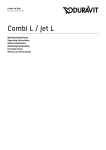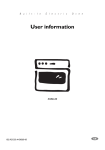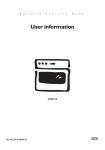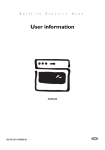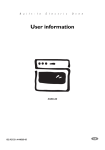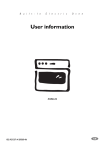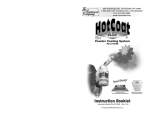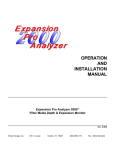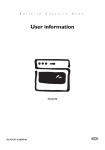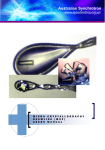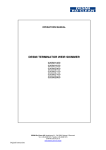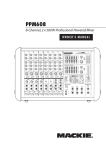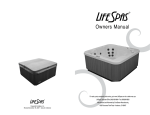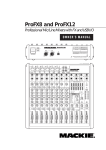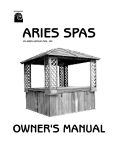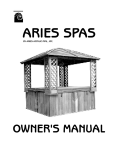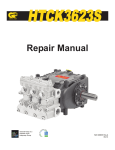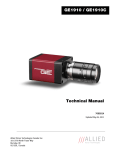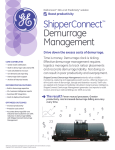Download SALES OFFICES - American Railcar Leasing
Transcript
SALES OFFICES Headquarters St. Charles, MO 63301 (636) 940-5000 Northeastern District 475 Market Street Elmwood Park, NJ 07407 (201) 794-6828 Southern District 1610 Woodstead Court Suite 230 The Woodlands, TX 77380-3403 (281) 364-0190 Mid-Western District 15 Spinning Wheel Road Suite 108 Hinsdale, IL 60521-2983 (630) 325-4600 Canadian District ARL Canada Limited 1 Avenue Holiday, East Tower Suite 501 Pointe-Claire, Quebec H9R 5N3 (514) 697-5958 ARL makes no representations or warranties, expressed or implied, with respect to the contents hereof, and assumes no contractual or other liability with respect to any use which customer may make of this Service Manual. For further information, telephone or write either the nearest representative of American Railcar Leasing LLC, or phone directly to American Railcar Leasing LLC, St. Charles, Missouri at 636-940-5000. © 2012 American Railcar Leasing LLC Printed in U.S.A. CENTER FLOW ® PRESSUREAIDE ® CAR CENTER FLOW ® PRESSUREAIDE ® CAR TABLE OF CONTENTS GENERAL MAINTENANCE Part I. PAGE Introduction . . . . . . . . . . . . . . . . . . . . . . . . . . . . . . . . . . . . . . . . . . . . . . . . 2 Part II. Pre-Trip Car Inspection . . . . . . . . . . . . . . . . . . . . . . . . . . . . . . . . . . . . . . . 4 RUPTURE DISC ASSEMBLY PRESSURE RELIEF VALVES Part III. Air Requirements . . . . . . . . . . . . . . . . . . . . . . . . . . . . . . . . . . . . . . . . . . . . 5 The rupture disc assembly must be inspected annually, or if the security seal is broken. The pressure relief valves must be visually inspected as part of the preload inspection to remove any dirt or debris that may have collected in the discharge opening. The discharge pressure must be tested annually. The pressure test can be performed either on the car, or on a test bench. Part IV. Operating Instructions . . . . . . . . . . . . . . . . . . . . . . . . . . . . . . . . . . . . . . . . . . Operating Controls . . . . . . . . . . . . . . . . . . . . . . . . . . . . . . . . . . . . . . General Unloading Instructions . . . . . . . . . . . . . . . . . . . . . . . . . . . . . . Hook-up . . . . . . . . . . . . . . . . . . . . . . . . . . . . . . . . . . . . . . . . . . . . . . Pressurization . . . . . . . . . . . . . . . . . . . . . . . . . . . . . . . . . . . . . . . . . . . Unloading . . . . . . . . . . . . . . . . . . . . . . . . . . . . . . . . . . . . . . . . . . . . . Unloading Assists (Vibration and Fluidization) . . . . . . . . . . . . . . . . . . . 6 6 7 8 8 9 9 Part V. General Maintenance . . . . . . . . . . . . . . . . . . . . . . . . . . . . . . . . . . . . . . . . Pressure Gauges . . . . . . . . . . . . . . . . . . . . . . . . . . . . . . . . . . . . . . . . . Rupture Disc . . . . . . . . . . . . . . . . . . . . . . . . . . . . . . . . . . . . . . . . . . . Pressure Relief Valves . . . . . . . . . . . . . . . . . . . . . . . . . . . . . . . . . . . . . Hatches . . . . . . . . . . . . . . . . . . . . . . . . . . . . . . . . . . . . . . . . . . . . . . . 10 10 11 12 13 1. Break the security wire and remove the four nuts securing the weather cover. 2. Visually inspect the disc looking for signs of rupture, tears or holes. An air leak test can be performed by pressurizing the car body to 10 psig and using a soap solution. PRESSURE SETTINGS Car body valve - 14.5 psig +/- 0.5 psig. Air manifold valve - 16.0 psig +/- 0.5 psig. 3. If the disc requires replacement, depressurize the car and ensure the pressure gauges read “zero.” 1. Pressure relief valve maintenance cannot be performed in the field. If the “start to discharge” 4. Remove the four bolts, separate the flanges pressure falls outside the +/- 0.5 psig tolerance, and discard the old rupture disc. the valve can be replaced in kind or returned to American Railcar Leasing for rebuilding. This 5. Inspect and clean the disc seating surfaces on includes adjustment of the start to discharge each flange removing any nick or burrs then pressure. Oil and grease must be kept away from the lightly polish with emery cloth. inside of the valve as it is designed to operate without lubrication. 6. Remove the new rupture disc from the packaging and visually examine to ensure it is in 2. To remove the pressure relief valves, use a good condition. Confirm the pressure rating is standard open-end wrench to engage the flats on 20 psig. The disc must be specifically manufacthe bottom of the valve. Do not apply force to tured for use in the rupture disc holder assembly. the valve body or the discharge connection. 7. Place the rupture disc on the inlet flange. The convex side of the disc must be in the up position so pressure inside the car will be against the concave side of the disc. 8. Replace the upper flange. Install the four bolts finger tight to ensure all components are properly aligned and seated. Torque the nuts to 34-38 ft-lbs. Do not over tighten as damage to the rupture disc may occur. Part VI. Cleaning . . . . . . . . . . . . . . . . . . . . . . . . . . . . . . . . . . . . . . . . . . . . . . . . . . . 15 Part VII. Troubleshooting . . . . . . . . . . . . . . . . . . . . . . . . . . . . . . . . . . . . . . . . . . . . . 16 Part VIII. Parts List . . . . . . . . . . . . . . . . . . . . . . . . . . . . . . . . . . . . . . . . . . . . . . . . . . . 19 Part IX. Specification Sheet . . . . . . . . . . . . . . . . . . . . . . . . . . . . . . . . . . . . . . . . . . 24 Part X. ARL CF 5650 Pressureaide Introduction . . . . . . . . . . . . . . . . . . . . . . . . . . . . . . . . . . . . . . . . . . . . Specification Sheet . . . . . . . . . . . . . . . . . . . . . . . . . . . . . . . . . . . . . . . Operation Equipment and Locations . . . . . . . . . . . . . . . . . . . . . . . . . . Operation Instruction and Controls . . . . . . . . . . . . . . . . . . . . . . . . . . Standard Hatch Arrangement . . . . . . . . . . . . . . . . . . . . . . . . . . . . . . . . Hatch Lever Adjustment Instructions . . . . . . . . . . . . . . . . . . . . . . . . . . Unloading Operations . . . . . . . . . . . . . . . . . . . . . . . . . . . . . . . . . . . . . Cleaning . . . . . . . . . . . . . . . . . . . . . . . . . . . . . . . . . . . . . . . . . . . . . . . General Maintenance . . . . . . . . . . . . . . . . . . . . . . . . . . . . . . . . . . . . . Troubleshooting . . . . . . . . . . . . . . . . . . . . . . . . . . . . . . . . . . . . . . . . . 3. Reinstall the valve by applying a moderate coating of pipe compound or plumber’s tape to the male threads of the pipe connection. Keep the compound away from the first few threads to prevent contamination of the valve, car or piping. DUST CAPS Inspect the chains, gaskets and cam lever hardware on each dust cap. Replace damaged or missing parts. 25 26 27 29 32 33 34 36 39 16 9. Reinstall the cover, tighten nuts 20-25 ft-lbs. and install a new security wire with lead seal. 40 1 PART I. CENTER FLOW ® PRESSUREAIDE ® CAR CENTER FLOW ® PRESSUREAIDE ® CAR INTRODUCTION GENERAL MAINTENANCE The car must be depressurized before performing any maintenance function. Open the blow down valve, then one fluidizing, one by-pass valve and one product valve. Confirm the pressure gauges read “zero”. HATCH GASKET REPLACEMENT PRESSURE GAUGES Remove the old gasket by inserting a flat head screwdriver along the outer wall of the gasket groove and prying underneath the gasket. Take care not to gouge the metal surface. Once enough of the gasket is exposed, pull the remainder out by hand. The pressure gauges must be calibrated on an annual basis. Two tee connections are located on the back side of the pressure gauge housing. These fittings connect the gauge inlet lines, the pressure gauges and the petcocks. Do not pry against the inner wall of the gasket groove, as this could result in damage to the dovetail. 1. Clean the gasket groove with a commercial adhesive remover to remove any residue then wipe down both sides of the new gasket and allow to dry. Figure 1. Center Flow® Pressureaide® Car 1. Remove the petcocks and connect calibrated test gauges to the tees. If necessary, the gauge inlet lines can be cleared with compressed air. 2. Close all product and air valves except for one fluidizing valve. 3. Connect an air supply line and pressurize the car to 10.0 psig. The ARL Pressureaide® pressure differential Center Flow® covered hopper car is designed to handle dry bulk commodities. With operating pressures up to 14.5 psig, fast, efficient unloading for long distances can be achieved. Unloading rates up to 100,000 lbs/hour may be obtained depending upon the commodity and unloading system. 2. Apply a thin layer of Scotch-Grip EC1357 Contact Adhesive to the bottom of the gasket. Allow the adhesive to set until the surfaces become tacky. 4. The pressure reading between the car gauge and the test gauge must be within 1.0 psig. If the car gauge falls outside this range, remove the gauge and replace. The Pressureaide® car has many of the famous Center Flow® car design features: centerline loading, unloading, complete sanitation and ease of operation. Designed to operate with standard positive displacement blowers, this car may be used with equipment compatible with pressure sleds. As safety is a prime consideration for American Railcar Leasing LLC, the Pressureaide® car is equipped with two pressure relief valves, a rupture disc and a vacuum relief valve. 3. Install the gasket by slipping one edge into the dovetail. Repeat this every 90 degrees. Continue pressing the gasket into the dovetail with thumb pressure or the heel of your hand. A small roller can also be used. Make sure the gasket is properly seated. 5. If there is no pressure reading, stop the blower and open the blow down valve to allow the car to depressurize. The Pressureaide® car is unmatched by any railcar in its class when it comes to sanitation, maintenance and unloading performance. 4. Wipe away any excess adhesive. 5. Close the cover, center on the hatch ring and latch all cam levers. Check lever closing force. 2 6. Disconnect the fitting at the back of the gauge panel, close the petcock and using compressed air, blow back through the gauge line to clear away any product that may be causing a blockage. 7. Reassemble the gauges and retest. 39 CENTER FLOW ® PRESSUREAIDE ® CAR CENTER FLOW ® PRESSUREAIDE ® CAR CLEANING 8'-3 1/2" DRYING PROCESS 1. After all compartments have been cleaned, be sure all the fluidizing valves are in the full open position to allow airflow through the membranes until the compartment is dry. 2. Shut down the blower and allow dry residual air to vent from the car to avoid any potential for pressure to build in the car or manifold. 3. Close and secure all hatches. 4. Close the product valves and re-install the caps or closure plates on the clean out ports. 5. Restart the blower and pressurize the car to 10 psig. 6'-4" 5'-4 1/4" 5'-0" 5'-0" 5'-0" 5'-4 1/4" 6'-4" 8'-3 1/2" 7. After drying the last compartment, open the by-pass air and product valves and allow airflow for two minutes. 8. Shut down the blower. The car will depressurize through the product valves. Ensure the pressure gauges read “zero” before going to step 9. Open blow down valve to ensure there is no pressure in the car body. Figure 2. Standard 8-Hatch Arrangement For Models 5000 and 5001 Figure 2 shows the standard roof hatch and bulkhead arrangement for the models 5000 and 5001 Pressureaide® cars. Each compartment has two hatches located on the car’s longitudinal centerline. Intermediate bulkheads are designed to permit simultaneous loading of adjacent compartments from one hatch. 9. Remove the discharge hoses and dust caps or closure plates from the clean out ports. 10. Inspect the clean out ports. Swab out any remaining water and residue. Re-install the quick disconnect caps or closure plates. 11. Disconnect the air supply line. 6'-5 1/2" 9'-1" 5'-4 1/4" 6'-3" 6'-2 3/16" 6'-3" 5'-4 1/4" 9'-1" 6'-5 1/2" 12. Close all valves. Install and secure the quick 6. Open the product valve on an end compartdisconnect caps on the air inlets and product ment and allow airflow for two minutes to clear any remaining water from the product line. Close discharge connections. the valve and repeat the procedure on the next hopper. Figure 3. Standard 8-Hatch Arrangement For Models 5003 and 5007 Figure 3 shows the standard roof hatch and bulkhead arrangement for the models 5003 and 5007 Pressureaide® cars. Each compartment has two hatches located on the car’s longitudinal centerline. Intermediate bulkheads are designed to permit simultaneous loading of adjacent compartments from one hatch. 38 3 PART II. CENTER FLOW ® PRESSUREAIDE ® CAR CENTER FLOW ® PRESSUREAIDE ® CAR PRE-TRIP CAR INSPECTION CLEANING The Pressureaide® car is a special piece of equipment, as such, it requires regular preventative maintenance. Part of this program includes a thorough pre-trip inspection prior to loading. PRESSURE RELIEF VALVE, RUPTURE DISC, VACUUM RELIEF VALVE LOCATED ON ROOF “A” END FLUIDIZING AIR VAVLES BLOWDOWN VALVE FLUIDIZING AIR VALVES "A" Comp. PRESSURE GAGES “B” END "AC" Comp. PRODUCT VALVE AIR INLET (FAR SIDE) BY-PASS AIR VALVE PRODUCT DISCHARGE CLEAN-OUT PORT MANIFOLD PRESSURE RELIEF VALVE "BC" Comp. "B" Comp. AIR INLET (NEAR SIDE) BY-PASS AIR VALVE BEFORE LOADING 1. If the car is to be cleaned, follow the procedures on page 15. 2. Ensure there is no water in the air manifold and that the product manifold and membranes are clean and dry. 3. Inspect all hatch covers, locking mechanisms and safety catches for proper operation. Ensure gaskets are clean and in good condition. 4. Inspect and operate all control valves (product, by-pass air, fluidizing air and blowdown) to ensure they are in proper working condition. 5. Inspect all dust caps. Ensure gaskets are in place and in good condition. Attachment chains and cam levers must be intact. 6. Inspect pressure gauges and protective covers. Be sure the gauges read zero with car depressurized and the cover is not broken. CLEANING PROCESS 1. In-plant confined space entry procedures must be followed to enter the car. 1. Start the blower to establish airflow through the membranes. It is critical to maintain airflow during the cleaning process. 2. Before opening hatches or removing caps, open the blow down valve, air inlet valve, by-pass valve and product valves to depressurize the car body and manifold system. SIDE SILL CLEAN-OUT PORT 2. Wet washing can be accomplished using a hand held hose or a roto-jet inserted into an open hatch. Move from hopper to hopper, as necessary, to clean entire railcar. 3. Open all hatches on top of the car. Figure 4. Operating Equipment PRE-TRIP CHECKLIST WASHING PROCEDURES - PREPARATION 4. Connect a positive displacement blower to the air inlet connections. 8. If the cleanout port has a flanged cover, ensure its gasket is properly installed and all fasteners properly tightened. If the cleanout port has a dust cap arrangement, ensure the cap is properly installed, its gasket is in good condition and a proper locking seal is applied to the operating levers. 3. After cleaning, continue the airflow through the membranes until dry. 5. Attach product discharge hoses to each side of the car to direct the flow of air, water and residual product away from the personnel and the work area. 6. Close the two by-pass valves and open all of the fluidizing valves to the full open position. 9. Ensure all valves are closed prior to loading product into the car. If venting is required, it may be provided for by opening the blowdown valve or a hatch. Proper filters may be required to minimize dusting. 7. Open all of the product valves. 8. Remove the bolted cover plates from the clean out port on each compartment. AFTER LOADING 1. Check all caps for secure installation. 2. Ensure blowdown valve is closed. 3. Ensure cover over pressure gauges is closed. 4. All hatches must be closed and all holddowns properly engaged in the closed position. 7. Inspect all rubber hoses to ensure the hose clamps are properly installed and tightened and that the hoses are intact. 4 37 CENTER FLOW ® PRESSUREAIDE ® CAR PART III. CENTER FLOW ® PRESSUREAIDE ® CAR AIR REQUIREMENTS CLEANING GENERAL INSTRUCTIONS & CAUTIONS 1. In-plant confined space entry procedures must be followed to enter the car. 2. Ensure the car is not under pressure before opening hatches or removing caps. Open the blow down valve, air inlet valve, by-pass valve and product valves to depressurize the car body and manifold system, then check the pressure gauges to confirm all readings are zero. 3. If using ladders, they must be equipped with rubber feet to protect the interior lining. 4. Never place a ladder on the aeration membrane as damage will result. The Pressureaide® car has been designed to operate with air supplies from 200 CFM to 1000 CFM (CFM=Cubic Feet Per Minute). The air requirement for a particular system depends on the diameter and configuration of the conveying line and the characteristics of the material being conveyed. To determine the air requirements for a specific unloading system, furnish your ARL representative with the details of the system. As a general guide for air requirements in low-pressure pneumatic systems, refer to the following chart: 6. Do not direct high-pressure water at the membranes. 7. Steam cleaning or grit based blast should never be employed on cars with interior lining. 8. The most common methods for cleaning the interior of an ARL Pressureaide® car is using either of two proven methods: wet washing or dry scraping. If dry scraping, use pliable plastic tools and use extreme care not to damage the lining or membranes. AIR PRODUCT LINE VOLUME SIZE 4-inch (pipe) . . . . . . . . 440 CFM 5-inch (pipe) . . . . . . . . 680 CFM 6-inch (pipe) . . . . . . . 1000 CFM 9. Entry into the car is gained through the manway openings. Do not remove the plenum plates from the bottom of the car. CAUTION: UNDER NO CIRCUMSTANCES SHOULD MORE THAN 1000 CFM BE USED TO PRESSURIZE THE CAR NOR SHOULD CAR PRESSURE EXCEED 14.5 PSIG. 5. Avoid direct impingement of high-pressure water on the safety relief valve, vacuum relief valve and the rupture disc inlets located in the roof of the “A” and “B” hoppers. Best results are obtained by using a positive displacement blower which will develop air flow (CFM) at a minimum of 14.5 psig. However, there are many other types of blowers and air compressors that produce adequate air flow to operate the Pressureaide® car. Large industrial plant systems, which produce an adequate air flow, may be used to operate the Pressureaide® car provided they are equipped with a pressure regulator that limits the pressure to 20 psig, an adequate water trap and a good filter. NOTE: WHEN USING ANY AIR SOURCE, THE AIR MUST BE CLEAN, FREE FROM OIL AND WATER AND ITS TEMPERATURE MUST NOT EXCEED 250ºF. FAILURE TO DO SO MAY RESULT IN DAMAGE TO THE CAR’S MEMBRANES. 36 The Pressureaide® car has two membranes in the bottom of each compartment. Air directed through the membranes fluidizes the lading and pressurizes the car. The fluidization breaks down the internal strength of the lading and the pressurization provides the energy to convey the lading. To ensure the system works properly, the air inlet side of the membranes must remain clean. This requires that precautions be taken at the unloading site: 1.) Air inlet hose must be free of product and/or other foreign material. 2.) Air supply should be clean and dry. In situations where by-pass air lines are used (see Figure 5) a check valve and metering valve arrangement should be part of the system. The purpose of the metering valve is to permit proper adjustment of air flow into and by the car, while the check valve is to ensure against a backflow of lading into the blower package and the car’s air inlet line in the event the air supply is interrupted during the unloading process. Unloading systems utilizing automation are special cases. If the unloading system uses automated controls, contact an ARL representative. Potentially undesirable situations may be avoided after a brief review of the railcar and its relationship with the system. TO STORAGE BIN BLOWER PACKAGE BYPASS LINE METERING VALVE CHECK VALVE AIR INLET PRODUCT DISCHARGE PRESSUREAIDE® CAR Figure 5. Product Discharge With By-Pass 5 PART IV. CENTER FLOW ® PRESSUREAIDE ® CAR CENTER FLOW ® PRESSUREAIDE ® CAR OPERATING INSTRUCTIONS OPERATING CONTROLS UNLOADING OPERATIONS 1. Pressure Relief Valves (Refer to figures 4 and 6) - The car is equipped with a pressure relief valve on the “A” end of the car body that is set to open at 14.5±0.5 psig. The car is also equipped with a pressure relief valve on the air inlet manifold (see figure 6) which is set to open at 16± 0.5 psig. DETAIL OF FOUR-WAY FLUIDIZING AIR VALVE CLOSED FAR SIDE OPEN 19. Close all valves and hatches and apply tamper evident seals, if required. CLEANOUT PORTS Figure 6. Manifold Assembly With Four-Way Fluidizing Air Valve HOW THE FOUR-WAY FLUIDIZING AIR VALVE OPERATES (DIRECTION OF HANDLE DETERMINES DIRECTION OF FLOW) NEAR SIDE OPEN CHECK VAVLE BY-PASS AIR VALVE PRODUCT VALVE AIR INLET FITTING AIR INLET PRESSURE RELIEF VALVE 18. Shut down the blower after the car and conveying lines are blown clean. After the blower stops: depressurize the car body by opening the blow down valve. (An alternate method of depressurizing the car body is to open the product valves, bleeding pressure through the plant dust collection system.) When airflow has stopped, open one product valve and one fluidizing or by-pass valve. Ensure the pressure gauges read “zero,” then disconnect the air supply and product hoses. Replace and secure the dust caps on the Product and Air inlet connections. FULLY OPEN FLUIDIZING AIR VAVLE PRODUCT VALVE MANIFOLD ASSEMBLY PRODUCT VALVE PRODUCT DISCHARGE FITTING FOUR-WAY VALVE FLUIDIZING AIR VALVE AIR FLOW AIR INLET FITTING FLUIDIZING AIR VALVE AIR FLOW BY-PASS AIR VALVE CHECK VAVLE PRESSURIZING THE CAR BODY & UNLOADING (Cont.) 6 35 CENTER FLOW ® PRESSUREAIDE ® CAR UNLOADING OPERATIONS PRESSURIZING THE CAR BODY & UNLOADING 1. Open both by-pass valves, then start the blower to initiate air flow to the air manifold. 2. Confirm that air is flowing freely to the silo, truck or other receiving vessel. An increase in manifold pressure or the opening of a safety relief valve is evidence of a plugged line. 3. Open the air valve to the Full Open position for the hopper to be unloaded. 4. Close both by-pass valves to begin pressurizing the car. 5. As the car body pressurizes, check for leaks in the form of dusting at the clean-out ports, hatches, piping and hose connections and the bolted plenums. If dusting is observed, stop the blower and depressurize the car. Identify and correct the problem. 6. Open one of the by-pass valves to its full open position to establish flow through the discharge manifold. Utilize the by-pass valve at the “A” end for hoppers “A, AC and C.” For unloading the “B” and “BC” hoppers, utilize the by-pass valve on the “B” end of the car. 7. Open the product valve and adjust it and the by-pass valve as required to establish the optimal unloading rate. 8. Monitor the car body pressure throughout unloading. Pressure requirements will vary with the commodity being shipped and the unloading system. The car body operating pressure must never exceed 14.5 psig. CENTER FLOW ® PRESSUREAIDE ® CAR 2. Rupture Disc - A rupture disc is applied to the car body as a back-up safety device. The disc is designed to rupture at 20 psig at 72ºF and is located on the roof of the car. 3. Lading Controls - The product discharge portion of the manifold is equipped with a product valve at each hopper. The air inlet portion of the manifold is equipped with a valve arrangement at each hopper to permit selective fluidization of the hoppers and prevent the car from losing pressure if the blower inadvertently shuts down or if it’s necessary to disconnect the air inlet or product discharge hoses while the car is pressurized. 9. Should the car body pressure exceed 15.0 psig and the pressure relief valve fails to open, shut off the air supply and depressurize the car. The pressure relief valve must be replaced prior to proceeding with the unloading operation. 10. Typically, optimum unloading rates are obtained when the air manifold pressure is 1.0 psig to 3.0 psig higher than the car body pressure. Monitor the pressure at the gauges and adjust valves as required. (This is dependent on the product and unloading system.) A series of adjustments, using the by-pass valve may be required to obtain optimum product flow. In general, the longer the conveying distance, the more by-pass air is required. NOTE: BEFORE REMOVING ANY DUST CAP, OPEN THE BLOWDOWN VALVE, ANY FLUIDIZING VALVE AND ANY PRODUCT VALVE. IF GAUGE READINGS ARE NOT ZERO, CHECK FOR FAULTY GAUGES. 11. When the hopper empties, there will be a rapid drop in car body pressure. 1. All hatches are secure (See Figure 7). SAFETY LOCK TYPICAL HATCH Figure 7. Loading Hatches 2. Blowdown valve is in closed position (See Figure 8). BLOWDOWN VALVE 4. By-pass Air Controls - A butterfly check valve arrangement is installed in the air supply portion of the manifold at each end of the car. This permits air to be metered into the product discharge line. The check valves are installed to prevent the back flow of lading if there is an interruption in the air supply. 12. Close the product discharge valve. 13. Move to the next hopper and open the air valve to the Full Open position. 14. After unloading a hopper, close the air valve and the by-pass valve. The car body will begin to pressurize for unloading the next compartment. 5. Blowdown Valve - A manually operated blowdown valve is applied to the “A” end bulkhead to depressurize the car. This valve is equipped with a handle extension to permit operation from ground level. 15. Repeat the above process (steps 3-14) for the next hopper to be unloaded. GENERAL UNLOADING INSTRUCTIONS 16. As this is a single compartment car, some spillage may occur between hoppers during the unloading process. To provide complete clean out, repeat the above procedures for all compartments. 17. After all hoppers are emptied, open both by-pass valves and close all other valves. Allow supply air to thoroughly clean out the car’s manifold and plant’s product conveying lines. Prior to hook-up for unloading, inspect car thoroughly to ensure: NOTE: BEFORE REMOVING ANY DUST CAP, OPEN THE BLOWDOWN VALVE, ANY FLUIDIZING VALVE AND ANY PRODUCT VALVE. IF GAUGE READINGS ARE NOT ZERO, CHECK FOR FAULTY GAUGES. 34 TO OPEN TO CLOSE SPRING LOADED THROTTLE HANDLE FABRICATED HANDLE Figure 8. Blowdown Valve 3. All product valves are closed. 4. All fluidizing air valves and by-pass air valves are closed. 5. Pressure gauges are intact and petcocks are closed. If petcocks are open, gauges will not give accurate readings. 7 CENTER FLOW ® PRESSUREAIDE ® CAR HOOK-UP HATCH COVER ADJUSTMENT INSTRUCTION Prior to removing any dust caps, open the blowdown valve, any fluidizing valve and any product valve. WRENCHABLE LEVER ADJUSTMENT CAMLOCK FITTING (ALTERNATE HOOK-UP) FAR SIDE HOOK-UP AIR INLET MANIFOLD The levers are designed to function as a wrench providing the ability to adjust the closing force without additional tools. PRODUCT DISCHARGE LINE DUST CAP 1. Center the cover on the hatch ring. 2. Close the two levers at 90 degrees to the longitudinal centerline of the car. CAMLOCK FITTING Figure 9. Air Inlet Manifold 1. Remove dust cap and connect air supply line to air inlet fitting. Air supply can be connected to either side of the car (See Figure 9). NOTE: CARE MUST BE EXERCISED TO ENSURE AIR SUPPLY LINE IS CLEAN AND FREE OF CONTAMINATION. 2. Remove dust cap from product discharge line on car and connect product line (See Figure 10). 3. Ensure all valves on the car are closed after hook-up is completed. 4. Attach grounding straps to both the car body and the product discharge line. PRESSURIZATION 1. Open fluidizing air valve to full open position on the first compartment to be unloaded. 2. Start the blower and pressurize the car. Monitor the pressure with the car’s pressure gauges (one gauge reads car body pressure, the other gauge reads air inlet pressure). HINGE BLOCK LEVER ADJUSTMENT 1. Center the cover on the hatch ring. CAMLOCK FITTING DUST CAP AIR SUPPLY 8. Cable seals may be applied to either holes in levers or hatch cover and ring. 3. Loosen the 5/16” setscrew on the hinge block with a 5/32” allen wrench (older models may not have set screws). PRODUCT LINE 4. Turn the cam lever clockwise to increase the closing force, or counter clockwise to decrease. Figure 10. Product Discharge CAUTION: IF DUST EMITS FROM THE CAR, IMMEDIATELY STOP UNLOADING. DEPRESSURIZE THE CAR, MAKE A THOROUGH INSPECTION AND CORRECT THE PROBLEM. IF ANY CRACKS ARE FOUND IN THE CAR’S STRUCTURE, CONTACT AN ARL REPRESENTATIVE. IF THE CAR’S BODY PRESSURE EXCEEDS 15.0 PSIG AND THE PRESSURE RELIEF VALVE DOES NOT OPEN, SHUT OFF THE AIR SUPPLY, BLEED PRESSURE FROM CAR AND DETERMINE REASON FOR PRESSURE RELIEF VALVE MALFUNCTION. IF A MALFUNCTION OCCURS WHILE UNLOADING, REFER TO “TROUBLESHOOTING” SECTION ON PAGE 16. 3. When the car reaches the optimum operating pressure, it is ready to unload. The maximum car body operating pressure is 14.5 psig. Optimum pressures will vary depending upon the unload site’s pneumatic unloading system. 5. Adjust the levers diagonally opposite. 2. Close the two levers at 90 degrees to the longitudinal centerline of the car. 3. With the lever in the open position, and the bolt upright, lift the lever to engage the “wrench” feature with the flats on the nut. 6. Proceed to the next pair of levers. 7. Confirm the closing force on the levers and readjust as required. 8. Tighten the setscrews in the hinge block. 4. Turn the nut clockwise to increase the closing force, or counter clockwise to decrease. 9. Apply cable seals as required. 5. Adjust the levers diagonally opposite. 6. Proceed to the next pair of levers. 7. Confirm the closing force on all levers and readjust as required. 8 33 CENTER FLOW ® PRESSUREAIDE ® CAR CENTER FLOW ® PRESSUREAIDE ® CAR STANDARD HATCH ARRANGEMENT UNLOADING The PD5650N is designed with 7 hatches and no interior bulkheads to allow for “flood” loading of the car. 1. Open one by-pass valve to its full open position. Use the by-pass valve on the “A” end of the car for the “A” or “AC” compartment and the by-pass valve on the “B” end of the car for the “B” or “BC” compartment (See Figures 4 & 6). 2. Open the product valve on the compartment being fluidized. 3. In general, optimum unloading rates are obtained when the air inlet (manifold) pressure gauge reading is 1 to 3 psig higher than the car body pressure gauge reading. Meter the product flow to suit the unloading system’s capacity and to avoid plugging the conveying line by adjusting the product valve and by-pass valve to obtain the best product-to-air mixture. Long conveying distances generally require more by-pass air than short conveying distances. Check gauges to ensure proper pressures are being maintained. The hatches are secured with 6 cam lever closures. A safety catch is applied to the lever opposite the hinge of each cover. The safety catch prevents opening the hatch when the car body is under pressure. This lever must always be the last one opened. The ends of the two opposing levers are drilled for the application of a security seal. 4. If one side of the hopper is empty and the other side has material, use the four-way fluidizing valve to direct air to the side that has material in it. The hatch cover assemblies and gaskets must be inspected prior to each loading. Any missing or damaged parts must be replaced and the cam levers checked for proper adjustment. The lever closing force must be 40 pounds. Inspect the gaskets to ensure they are clean and undamaged. 9. After the last compartment is unloaded, open both by-pass valves and close all other valves. Allow the blower to run a sufficient amount of time to clean out the manifold and unloading site conveying lines. 10. SHUT DOWN THE BLOWER. 11. Open the blowdown valve on the “A” end of the car until all pressure is reduced to zero psig and air has stopped flowing out of the blowdown valve. Disconnect flexible air and product hoses and secure all dust caps. UNLOADING ASSISTS 1. Vibration - The unloading system for the Pressureaide® car will provide satisfactory cleanout with most commodities. If unusual conditions exist which require vibration for cleanout, contact your ARL representative. 2. Fluidization - The Pressureaide® car is equipped with fluidizing membranes in each compartment. The air used for pressurizing the car is adequate for fluidizing the lading and will provide complete cleanout when the recommended unloading procedures are followed. 5. A rapid drop in car body pressure normally indicates the compartment is empty. Close the by-pass and product valves while continuing to supply air. Open and close the product valve at about twenty second intervals four or five times for final cleanout. Use by-pass air valve as needed. 6. Open the fluidizing valve to the full open position on the next compartment to be unloaded. Close all other valves on the car. 7. Allow car body pressure to build to operating pressure. 8. Repeat steps 1 through 7 for each compartment. 32 9 PART V. CENTER FLOW ® PRESSUREAIDE ® CAR CENTER FLOW ® PRESSUREAIDE ® CAR GENERAL MAINTENANCE OPERATING INSTRUCTIONS & CONTROLS Ensure there is no pressure on any portion of the car before attempting to perform any maintenance. Open the blowdown valve, any fluidizing valve and any product valve before removing any dust caps. IFO MAN PRESSURE RELIEF DEVICES ATTACH COMPRESSED AIR LINE HERE TO CLEAR LINE GAUGE BOX COVER LD A rupture disc assembly on the car body is a standard feature. The rupture disc is a device that functions only once. It is set to burst at 20.0 psig. Once the rupture disc bursts, it is necessary to replace the burst disc inside the assembly. CAR Y BOD PRESSURE GAUGE BOX MANIFOLD PRESSURE CAR PRESSURE PROVISION FOR PADLOCK OR R. R. SEAL PETCOCKS PETCOCKS TEST GAUGE The vacuum relief valve balances pressure inside the car with outside conditions due to atmospheric changes. This safety device is a self-closing device that opens at -0.25 psig or -0.5 inches Hg. Its purpose is to protect the railcar’s body from deformations due to atmospheric pressure changes. It will not protect the railcar’s body in the rare event the railcar must be vacuum unloaded. If the railcar must be vacuum unloaded, contact American Railcar Leasing. TEST GAUGE Figure 11. Pressure Test Gauges Figure 12. Disconnected Tubing From Gauges PRESSURE GAUGES (Refer to Figures 11 and 12) Calibration of the pressure gauges should be checked annually. To do this, install test gauges to the fittings where the petcocks are located. Hook up the blower’s air supply line to the car’s air inlet. All valves, except one fluidizing valve, should be closed. With the fluidizing valve in the full open position, pressurize the car to 10 psig. If the car body or manifold gauge deviates from the test gauge by more than one psig, return the gauge to American Railcar Leasing LLC. If the pressure indicating needle does not move after the blower has been started, stop the blower and relieve the pressure in the car by opening the blowdown valve. Disconnect the fittings at the back of the gauges, the blowdown valve and the air manifold. Attach a compressed air line to the gauge line and blow the line clean. Reassemble and check gauges. 10 31 CENTER FLOW ® PRESSUREAIDE ® CAR CENTER FLOW ® PRESSUREAIDE ® CAR OPERATING INSTRUCTIONS & CONTROLS PROTECTIVE COVER VACUUM RELIEF VALVE RUPTURE DISC BLOW DOWN VALVE TOP OF CAR The car is equipped with a blow down valve to depressurize the car body. The valve is located on the “A” end of the car and is operated from ground level with a handle extension. The valve is closed when the handle position is parallel to the valve body. Note: This valve discharges air and dust at high velocity. Personnel must stand clear. PRESSURE RELIEF VALVE BLOWDOWN VALVE "A" END Figure 13. Safety Valves PRESSURE RELIEF DEVICES The Pressureaide® car is equipped with two self-closing pressure relief valves: a car body pressure relief valve and a manifold relief valve for the air inlet manifold. The car body pressure relief valve is set to open at 14.5 ± 0.5 psig. The valve automatically closes when the pressure inside the car body is relieved. The relief valve in the air inlet is set to open at 16.0 ± 0.5 psig and will reseat when the pressure is relieved. RUPTURE DISC (Reference Figure 13) DISASSEMBLY AND ASSEMBLY OF RUPTURE DISCS (Reference Figure 14) Inspect the rupture disc annually. If the seal is broken, remove the protective cover and check the disc. Disc should be intact and in good condition. If condition is in doubt, pressurize the car to 10 psig and inspect for leakage. If a leak is detected, depressurize the car and replace the disc. 1. Remove protective cover (Item 1) by breaking sealing wire and removing four nuts. CAUTION: SUBSTITUTE OR MAKESHIFT DISCS ARE NOT TO BE USED. SEE THE PARTS LIST FOR SPECIFIED DISC. SEAL WIRE 1 1 SEATING SURFACE 3 5 2 RUPTURE DISC 4 30 Figure 14. Rupture Disc Assembly 2. Inspect the rupture disc (Item 5) to determine if it has ruptured or if there are any imperfections (tears, holes, etc.). 3. If disc must be replaced, remove flange (Item 2) by removing four bolts and nuts (Item 3). 4. Foreign matter or rough surfaces may damage the rupture disc or cause leakage. Clean seating surfaces of both inlet and outlet flanges (Items 2 & 4) before installing the rupture disc. Polish with a fine emery cloth. 5. When installing the rupture disc, handle carefully. Examine seating and prebulged surfaces. DO NOT INSTALL A DAMAGED DISC! Damage to seating area may cause leakage. Damage to prebulged surface of disc may affect disc rating. A vacuum support is permanently attached to concave side of disc. If missing or damaged, replace the disc with a new one. NOTE: DISCS ARE PACKAGED IN PROTECTIVE CONTAINERS. DO NOT INSTALL SHIPPING PROTECTOR. 11 CENTER FLOW ® PRESSUREAIDE ® CAR 6. Place rupture disc (Item 5) on inlet fitting (Item 4) with crown up. SYSTEM PRESSURE MUST BE AGAINST CONCAVE SIDE OF DISC. 1. To remove valve, unscrew by placing a flat jawed wrench on flats provided. Do not use the valve outlet or cap as a lever. 2. To reinstall the valve, apply a moderate amount of pipe compound to male threads only, leaving the first thread clean. Compound applied to female threads or used to excess can find its way into the valve causing leakage. 8. Install protective cover and torque second set of nuts to 20 to 25 ft. lbs. NOTE: DO NOT OVERTIGHTEN. 9. Install wire through holes in bolts and seal. PRESSURE RELIEF VAVLE (SETTING 14.5 PSIG) APPLY FLAT WRENCH THIS SURFACE ROOF OF CAR PRESSURE RELIEF VALVE (SETTING 16 PSIG) OPERATING INSTRUCTIONS & CONTROLS may be done with the valves installed on the car or they may be removed and bench tested. 7. Carefully place outlet flange (Item 2) in position. Install bolts and nuts and torque evenly to 34 to 38 ft. lbs. Make sure flanges are not cocked. DO NOT OVER TORQUE! Angular seating surfaces help seal disc with minimum bolt loading. Excessive tightening may damage the rupture disc. CENTER FLOW ® PRESSUREAIDE ® CAR UNLOADING CONTROLS Each compartment is equipped with a product discharge valve to regulate the flow of product entering the discharge manifold and an inlet valve for controlling fluidizing air to each hopper. AIR VALVE BY-PASS VALVE FLOW 3. The opening pressure for the relief valve mounted on the roof of the car is 14.5 psig. The opening pressure for the valve on the air inlet line is 16 psig. If the opening pressures vary by more than ±0.5 psig, return the valve to American Railcar Leasing LLC. BY-PASS VALVE 4. Do not paint, oil or otherwise cover any interior or working parts of the pressure relief valves. These valves do not require any lubrication or protective coating to work properly. CHECK VALVE AIR VALVE CHECK VALVE A check valve and by-pass valve is installed in series in the air supply line where the air supply connects to the discharge manifold. This arrangement permits conveying air to be metered into the discharge line. FLOW AIR INLET MANIFOLD LOOKING UP AT AIR INLET PIPING Figure 15. Pressure Relief Valves PRESSURE RELIEF VALVE (Reference Figure 15) Pressure relief valves should have a regular program of visual inspection. Build up of dirt and/or foreign material around and in the valve as well as broken parts will adversely affect the valve’s operating characteristics. The valves should be checked annually to ensure they are opening at the specified pressures. This 12 29 CENTER FLOW ® PRESSUREAIDE ® CAR CENTER FLOW ® PRESSUREAIDE ® CAR OPERATING EQUIPMENT & LOCATIONS 3 4 1 2 BLOWDOWN VALVE VACUUM RELIEF VALVE CAR BODY SAFETY RELIEF VALVE CAM LEVER RUPTURE DISC E LIN ER NT CAR E C OF ADJUST THESE LEVERS FIRST SAFETY CATCH 5/16"* SET SCREW (Optional) COUNTER-CLOCKWISE (LOOSEN) CCW CW TYPICAL HATCH *REQUIRES A 5/32" ALLEN WRENCH HATCH HINGE PIN “A” END HATCHES (Reference Figure 16) simultaneously). All levers should require approximately 40 lbs. of force to engage. Hatch covers, holddown assemblies, safety catches and gaskets should be inspected prior to each loading. Broken or missing parts should be replaced and all cam levers properly adjusted. 4. Recheck all cam lever forces (some of the levers might require additional adjustment due to the gasket compression). HATCH COVER INSTALLATION AND ADJUSTMENT Use this procedure to adjust existing hatch covers and for installing new hatch covers. PRODUCT DISCHARGE CONNECTION (one near side, one far side not shown) MANIFOLD PRESSURE RELIEF VALVE CLEAN-OUT PORTS (one each hopper) HATCH ADJUSTMENT Figure 16. Hatches “B” END CHECK VALVES (4 locations) CLOCKWISE (TIGHTEN) 1. With all cam levers disengaged, center hatch cover on hatch ring. Ensure the hatch hinge pin is installed. This will center the cover along the centerline of the car, then it can be moved to the right or left to center it across the car. CHECK VALVES (4 locations) 2. Loosen set screw in the cam lever assemblies and adjust and engage the two cam levers located 90º from the hinge (some cam lever assemblies are not equipped with set screws). Both levers must be adjusted at the same time. (Rotate entire cam lever assembly clockwise to tighten and counter-clockwise to loosen). Levers should be adjusted so that each requires about 40 lbs. of force to lock down. 28 3. Adjust remaining cam levers (levers across from each other should be adjusted 5. Retighten all set screws. HATCH GASKET REPLACEMENT There are two gasket designs in service. Ensure you identify the proper arrangement before ordering gaskets for a hatch cover. For Hatch Covers using a retaining ring (See Figure 16): 1. Remove cap screws and shakeproof washers (Items 1 and 2). 2. Remove gasket retainer (Item 4) and old gasket (Item 3). 3. Thoroughly clean gasket retainer and seal on hatch cover and hatch ring. 4. Install new gasket and reassemble. 5. Adjust per “Hatch Cover Installation and Adjustment” instructions. 13 CENTER FLOW ® PRESSUREAIDE ® CAR CENTER FLOW ® PRESSUREAIDE ® CAR OPERATING EQUIPMENT & LOCATIONS DUST CAPS Dust caps should be inspected prior to each loading. INNER GROOVE WALL PRODUCT VALVES (one each hopper) 1. Open the blowdown valve, any fluidizing valve and product valve before removing any dust cap. OUTER GROOVE WALL Figure 17. Hatch Cover Gasket AIR VALVES (one each hopper) 2. Inspect for missing caps, broken or missing cam levers, gaskets and chains. Replace items as required. For Hatch Covers not using a retaining ring (See Figure 17): “A” END “B” END 1. Remove the worn gasket. This may be facilitated by inserting a flat head screwdriver or knife blade along side of the straight outer groove wall and prying upward. When enough gasket is exposed to grab onto, pull remaining gasket from its groove. Do not pry from or damage the dovetailed inner groove wall. 2. Clean the gasket groove with a good solvent, such as methyl-ethyl ketone, to remove any adhesive build-up. Wipe all surfaces of the new gasket with a clean, solvent-moistened rag to remove any dust or mold release agent that may be present. Allow solvent to dry. Coat the bottom of the groove with a uniform, thin layer of adhesive such as 3M’s Scotch-grip #1300 Rubber Adhesive. Allow a couple of minutes for adhesive to become tacky. Install new gasket, forcing it into the groove beginning at the inner groove wall at four points approximately 90º apart. Continue forcing the gasket in the groove using hand and thumb pressure until gasket is uniformly seated in its groove. A small steel wheel roller may help facilitate the last step. PRESSURE GAUGES 3. After the gasket is in place, be sure there is no excess adhesive exposed. Remove any excess with a clean, solvent-moistened rag. At this point the hatch cover should be reinstalled and/or cammed shut to ensure sufficient pressure for complete adhesive contact. Adjust per “Hatch Cover Installation and Adjustment” instructions. BY-PASS AIR VALVE PRODUCT DISCHARGE CONNECTION (one near side, one far side not shown) AIR INLET (near side, far side not shown) BY-PASS AIR VALVE Note: Near side refers to the side of the car with the manifold piping. Far side refers to the side of the car opposite the manifold piping. 14 27 CENTER FLOW ® PRESSUREAIDE ® CAR PART VI. CENTER FLOW ® PRESSUREAIDE ® CAR CLEANING SPECIFICATION SHEET GENERAL CLEANING 1. Steam or grit blasting is not recommended as either may cause damage to the lining or permeable membrane. The most common methods of cleaning hopper cars are dry cleaning by scraping residue off with plastic or wood scrapers and washing with water. 2. When entering the car, a ladder should be used which is equipped with rubber or suitably padded feet to protect the permeable membrane. The ladder should not be allowed to rest on the membranes, nor should workmen walk on them. Of course, a ladder of adequate length should be used as well as following procedures compatible with good safety practices. Scaffold brackets to assist in dry cleaning the car’s interior can be provided if desired. NOTE: RESIDUE FROM CLEANING WILL END UP IN PRODUCT DISCHARGE MANIFOLD. THIS RESIDUE CAN BE REMOVED THROUGH THE CLEANOUT PORT PROVIDED IN THE DISCHARGE OUTLET CASTING OR BY PRESSURIZING THE CAR AND OPENING EACH PRODUCT VALVE INDIVIDUALLY. SPECIFICATIONS Length Over Pulling Face Truck Centers Overall Height Width Over Side Sheet Height Rail to Bottom of Discharge Outlets Number of Compartments Number of Outlets per Hopper Size of Roof Hatches Slope End Floor Sheet Slope Interior Floor Sheet Slope Side Slope Sheet Cubic Capacity Estimated Nominal Lightweight Horizontal Curve Negotiability - Uncoupled 64’-3 1/2” 51’ 15’-6” 10’-4” 9 1/8” 1 with 5 hoppers 1 20” DIA. 45º & 43º 45º 43º 5650 cu. ft. 66,900 lbs. 180 ft. CAUTION: IF THE CLEAN-OUT PORT HAS A FLANGED COVER, REPLACE CLEAN-OUT PORT FLANGE AND GASKET AFTER CLEANING. (TORQUE BOLTS TO 35 FT. LBS.) WASH PROCEDURE 1. Connect a positive displacement blower with a minimum capacity of 450 CFM to the air inlet connection. 2. Close both by-pass air valves and all four fluidizing air valves. Open all four product valves, remove dust covers from each side of the product discharge line and hook up hoses to direct air away from work station. Open hatches on top of car. 3. Starting at one end of car, set the fluidizing air valve to the full open position in the compartment being washed. 26 4. Start blower. 5. Wash compartment by using a rotojet inserted into the hatch opening or by a hand-held hose. AIR MUST CONTINUE TO BE BLOWN THROUGH MEMBRANE BEFORE, DURING AND AFTER WASHING. NOTE: CARE MUST BE TAKEN NOT TO DIRECT A HIGH PRESSURE STREAM OF WATER AT THE INLET PIPE OF THE RUPTURE DISC ASSEMBLY LOCATED ON CAR’S ROOF. THIS COULD CAUSE DAMAGE TO THE DISC. 6. When compartment has been washed, allow air to be blown through the membrane for an additional 10 minutes, then open the fluidizing air valve on the next compartment to be washed. Close the fluidizing air valve on the cleaned compartment. 7. Wash the remaining compartments following preceding instructions. 8. When all compartments have been washed, open all four fluidizing air valves and allow air to blow through the membranes until interior of car is dry. 9. Shut off blower, close and secure hatches and close all four product valves. Start blower and pressurize car to at least 10 psig. Starting at one end of the car, open the product valve for approximately two minutes to blow water and residue from the product line. Close the product valve, pressurize the car and repeat for the remaining compartments. CAUTION: ENSURE HOSES ARE HOOKED UP TO BOTH PRODUCT DISCHARGE CONNECTIONS TO DIRECT HIGH PRESSURE AIR AND RESIDUE AWAY FROM WORK STATION. 10. With blower still operating, open both air by-pass valves and then all four product line valves. Blow for two minutes then shut off blower. Allow the car to depressurize. Remove the product line and clean out the port cover. Inspect the discharge piping and the discharge casting; wipe out any remaining residue. 11. Ensure pressure gauges read zero, disconnect air supply line and replace all dust caps. Close by-pass valves and product line valves. 15 PART VII. CENTER FLOW ® PRESSUREAIDE ® CAR TROUBLESHOOTING PART X. CENTER FLOW ® PRESSUREAIDE ® CAR ARL CF 5650 PRESSUREAIDE INTRODUCTION CONDITION: CAR WILL NOT PRESSURIZE OR WILL NOT REACH OPERATING PRESSURE. CHECK FOR Proper operation of gauges. ACTION REQUIRED Petcock on gauge line must be closed. Check for clogged air line to gauge and clean if necessary. Check pressure gauge calibration (consult gauge manufacturer for instructions on calibrating gauges). Dust cap installed. Check air inlet, cleanout port and product line dust caps to ensure they are installed with gaskets intact. Adequate air supply. See Page 5 for air requirements. Obstruction or air leaks in air supply line. Remove obstruction and repair leaks. Blown rupture disc. See Page 11 for rupture disc service procedures. Leaking blowdown valve. Close valve. If leakage persists, clean seat. Leaking or prematurely opening pressure relief valve. Refer to service and repair procedures for pressure relief valve Page 12. Leaking vacuum relief valve. With the car under pressure, depress vacuum relief valve and release. Repeat 2-3 times. If this doesn’t work, depressurize the car and clean the valve seat. Leaking hatch covers. Check to be sure all hatches are closed and cam levers are secure. Figure 1. CF 5650 Pressureaide® Covered Hopper Car The CF 5650 Pressureaide® covered hopper car is specifically designed and engineered to handle a wide variety of dry bulk fluidizeable products, like flour, in a safe and efficient manner. Its clean bore design (no interior bulkheads) is well suited for flood load and pressure loading systems. The Pressureaide® car operates with internal pressures up to 14.5 psig, which allows for faster unloading. Safety is a priority with ARL; each car is equipped with two (2) pressure relief valves, a rupture disc and a vacuum relief valve. Clean hatch cover gaskets and gasket seats. Replace hatch gaskets and broken cam levers if necessary. See Page 13 for hatch adjustments. Open blowdown, by-pass or product valves, closed fluidizing valve. Close blowdown, by-pass and product valves. Open fluidizing valve. 16 25 PART IX. CENTER FLOW ® PRESSUREAIDE ® CAR CENTER FLOW ® PRESSUREAIDE ® CAR SPECIFICATION SHEET CONDITION: CAR WILL NOT PRESSURIZE OR WILL NOT REACH OPERATING PRESSURE, (Cont.) PRESSURE-TIGHT LOADING HATCH FOR PRESSURE DIFFERENTIAL CAR GASKET CHECK FOR COVER ACTION REQUIRED Leakage from car body. Contact an ARL representative. Jammed check valve in air inlet portion of the manifold. Check valve is located in the air inlet portion of the manifold. Loosen bolts, inspect and reposition. QUICK RELEASE CAM LEVER CONDITION: NO LADING FLOW OR REDUCED FLOW BASIC SPECIFICATIONS Length Over Strikers Truck Centers Overall Height Overall Width Height Rail to Bottom of Discharge Outlets (Light Car) Number of Hoppers Number of Outlets per Hopper Number of Roof Hatches Size of Roof Hatches Slope End Floor Sheet Slope Interior Floor Sheet Slope Side Slope Sheet Cubic Capacity Estimated Nominal Lightweight Horizontal Curve Negotiability Uncoupled 5000 5001 5003 5007 56’-11” 46’-3” 15’-6” 10’-7 3/16” 56’-11” 46’-3” 15’-4 13/16” 10’-6” 62’-5 1/4” 51’-9 1/4” 15’-5 9/16” 10’-3” 62’-5 1/4” 51’-9 1/4” 15’-5 9/16” 10’-3” 12 13/16” 4 1 8 20” Dia. 50º-45º 50º 45º 5000 cu. ft. 72,000 lbs 12 13/16” 4 1 8 20” Dia. 50º-43º 50º-45º 45º 5000 cu. ft. 66,900 lbs. 13” 4 1 8 20” Dia. 50º-43º 50º-45º 45º 5300 cu. ft. 70,300 lbs. 13” 4 1 8 20” Dia. 43º-45º 43º-45º 51º 5750 cu. ft. 70,100 lbs 150 ft. 150 ft. 180 ft. 180 ft. CHECK FOR Jammed check valve or fluidizing air valve in air lines. ACTION REQUIRED With blower running, rapidly open and close valve. Check to be sure fluidizing air valve is properly installed. See Figure 6. Remove valve and inspect for obstruction. Flapper must be free. If stuck, replace valve. Excessive back pressure in receiving vessel. Check receiving vessel for proper air vent. Clean air filters if applicable. Plugged line. Immediately close all product valves and all fluidizing air valves. Open both by-pass air valves to the full open position and restart blower, if shut off. If line can not be blown clear, (indicated by a line pressure drop) close by-pass air valves and shut off blower. CAUTION: If the blower must be shut down before line is clear, ensure the product valve on the most empty compartment is open. 3" BLOWDOWN VALVE PRESSURE GAGES The following reverse flow procedure may also be followed to clear a plugged line: 1. Open blowdown valve to depressurize car. (Leave valve open). SHPX COUPLER PULLING FACE 2. Close all product valves. 3. Close all fluidizing air valves. 12" 4. Open by-pass air valves to the full open position. 24 17 CENTER FLOW ® PRESSUREAIDE ® CAR CENTER FLOW ® PRESSUREAIDE ® CAR CONDITION: NO LADING FLOW OR REDUCED FLOW (Cont.) CHECK FOR Plugged line. (continued) Parts List NUMBER KEY PER UNIT ACTION REQUIRED 5W107206 5W107205 90011238 90038668 50093367 90018658 90004405 50092946 90004404 90007113 50091016 50092947 57333505 or 57334111 57333907 57333754* 57334107** 91002188 50093321* 50091480** 50093290* 2V610400** 5-W-1072-06 5-W-1072-05 --3-K-7329 ------2-K-8961 ----4-U-4326 3-K-8981-00 2-J-3995 or 2-V-5363 3-J-2077-01 --3-V-8073 --1-J-2685 1-V-5465 11-82043 2-V-6104 Manually disassemble and clean out product line between the car and the storage bin. NOTE: For replacement of rupture disc only, (Reference Page 11 - Figure 14 of this manual for service and repair procedure) order Rupture Disc Replacement Kit per Key No. 29. Close product valve and allow the pressure in the manifold line to build to the maximum capacity of the blower or to a maximum of 14.5 psig. Rapidly open and close product valve until reverse flow starts. Leave valve open until flow stops. Close product valve and repeat. When line pressure drops to a low pressure (less than 2 psig for most systems) with the product valve closed, the line is clear. When the plugged line has been cleared, close product valve and open both by-pass valves to clear manifold. Open fluidizing valve. Close blowdown valve to re-pressurize car and proceed with unloading. If the preceding procedures do not unplug the line, it will be necessary to disassemble the unloading line. Open one fluidizing valve. Open blowdown valve, depressurize car. Open product valve on most empty compartment. Close both by-pass air valves. CAUTION - Be sure product line is depressurized before attempting to disassemble. Insufficient air flow or inadequate blower. DRAWING NUMBER Shut off blower. Restart blower. 1 1 4 4 1 4 1 1 4 1 Cam Lever Assy. at Safety Catch Cam Lever Assy. Gasket For Hatch Cover For Retainer Type Gasket For Hatch Cover Without Retainer Gasket Retainer Cap Screw Shakeproof Washer Hinge Pin Washer Cotter Pin Cover (Includes Gasket) Safety Catch 2” Pressure Relief Valve Without Elbow Vacuum Relief Valve Blowdown Valve Assy. Blowdown Valve Assy. Tubing - Meter Box 25’ Section Pressure Gauge Pressure Gauge Gauge Cover Gauge Cover Rupture Disc Assy. Includes Key Nos. 20 Through 28 Lead Wire Seal Wire Stop Nut Washer S. S. Rupture Disc Valve Cover Hex Nut Rupture Disc Holder Rupture Disc Bolt With Seal Hole Rupture Disc Replacement Kit Includes Key Nos. 20, 21 and 27 CATALOG NUMBER 2 3 4 4A 5 6 7 8 9 10 11 12 13 14 15 15 A 16 17 17A 18 18A 19 20 21 22 23 24 25 26 27 28 29 Open product valve on the most empty hopper. 8 40 8 8 8 48 48 8 16 8 8 8 1 1 1 1 2 2 2 1 1 1 DESCRIPTION 50093602 --- --- --- --- --- --- --- --- --- 3-J-5612 ------------------- 50093596 2-J-5615 Check for proper size blower. Refer to guidelines on Page 5. Check blower for proper operation. Consult blower manufacturer, if required. Contact ARL representative. Rat holing (material hanging on side walls and outlet membrane covered). The membrane may be plugged. Unload compartment using manual assist if required. Contact an ARL representative. 18 * For Cars Built Before January 2000 ** For Cars Built In January of 2000 And Later 23 7 2 1 12 15 15A 16 22 4 15 SEE DETAIL 'C' 5 'A' END OF CAR 4 4A 2 3 19 17 14 6 7 18 13 14 19 20 21 22 DETAIL 'A' 11 11 8 12 11 7 SEE DETAIL 'B' SEE DETAIL 'A' 8 9 10 10 1 13 2 3 29 DETAIL 'C' FOUR-WAY VALVE 5 6 17 17A 16 21 23 18 18A CAUTION: SUBSTITUTION OR MAKESHIFT DISCS ARE NOT TO BE USED. USE ONLY 20 PSIG DISCS. DETAIL 'B' 4 19 IDENTIFICATION TAG INCL. KEY NOS. 20 THRU 28 9 8 20 24 28 26 27 25 24 23 22 CENTER FLOW ® PRESSUREAIDE ® CAR PART VIII. CENTER FLOW ® PRESSUREAIDE ® CAR PARTS LIST SPARE PARTS 19 CENTER FLOW ® PRESSUREAIDE ® CAR CENTER FLOW ® PRESSUREAIDE ® CAR MANIFOLD ASSEMBLY FOR CARS EQUIPPED WITH 5” PRODUCT LINE AND 4” AIR INLET LINE KEY NUMBER PER CAR 1 6 5” Alum. KamLok Cap 50093980 --- 2 6 Gasket - 5” KamLok Cap 90038105 --- 3 2 Hose 4 1/2” I.D. x 8 1/2” 50093438 2-J-3768-00 4 8 Hose Clamp - 5 1/8” 50093460 2-V-6794-01 5 2 4” Alum. KamLok Cap 50093981 --- 6 2 Gasket - 4” KamLok Cap 90038100 --- 7 12 Gasket - 5” Manifold 90038085 2-J-4059 8 4 Four-Way Valve 6J599700 6-J-5997 9 4 Valve Repair Kit 3V469500 3-V-4695 10 1 5” Cross - Alum. 5J979700 5-J-9797 11 4 Hose 5 9/16” I.D. x 8 1/2” 50093465 1-J-3336-01 12 8 Hose Clamp - 6 1/8” 50093464 2-V-6794-02 13 8 Hose 2 3/8” I.D. x 15 5/16” 50093454 I-J-3981 14 16 Hose Clamp - 3” 50093458 2-V-6794 15 1 Pressure Relief Valve 16 4 5” Butterfly Valve 57334109 3-V-8073-02 17 2 Flexible Hose 4 1/2” x 11 1/2” 50093439 2-J-3768-01 18 2 4” Butterfly Valve 57334108 3-V-8073-01 19 2 5” Check Valve (applies to model 5000) 50093501 3-J-3939-02 20 2 Gasket (1 required for use w/item 19) 2W688100 2-W-6881 21 2 Check Valve (models 5001, 5003, 5007) 4V438100 4-V-4381 22 4 Gasket (2 required for use w/item 21) 90038909 2-U-7457 23 8 Gasket 90038148 1-J-5874 24 4Gasket 90038147 1-J-5875 DESCRIPTION CATALOG NUMBER 57333501 or 2V908800 MOUNTING FRAME FLANGE DRAWING NUMBER 1 SEE VIEW 'A' VIEW 'A' VIEW LOOKING UP AT MEMBRANE 2 2A 4 7 4 6 5 3 2-J-3946 or 2-V-9088 Parts List For Models 5000, 5001 and 5003 NUMBER KEY PER UNIT 1 2 2A 3 4 5 6 7 8 4 4 248 528 248 32 32 DESCRIPTION CATALOG NUMBER DRAWING NUMBER Gasket & Membrane Assy. Membrane Support Assy. With Elbow As Shown Membrane Support Assy. With Elbow Rotated 180º H.H. Bolt Washer Stop Nut H.H. Bolt W/Nylon Patch Lock Washer - Hi-Collar 50092502 4U068701 4U068700 90034612 90004419 90002400 90034526 90004418 4-K-7333 4-U-0687-01 4-U-0687-00 ------2-J-2721 Parts List For Model 5007 NUMBER KEY PER UNIT 20 1 2 2A 3 4 5 6 7 8 4 4 280 624 280 64 64 DESCRIPTION CATALOG NUMBER DRAWING NUMBER Gasket & Membrane Assy. Membrane Support Assy. With Elbow As Shown Membrane Support Assy. With Elbow Rotated 180º H.H. Bolt Washer Stop Nut H.H. Bolt With Nylon Patch Lock Washer 50091430 4V463400 4V463401 90035259 90004475 90002170 90035258 90004259 4-V-4636-00 4-V-4634 4-V-4634-01 ------2-V-5335-00 --- 21





















